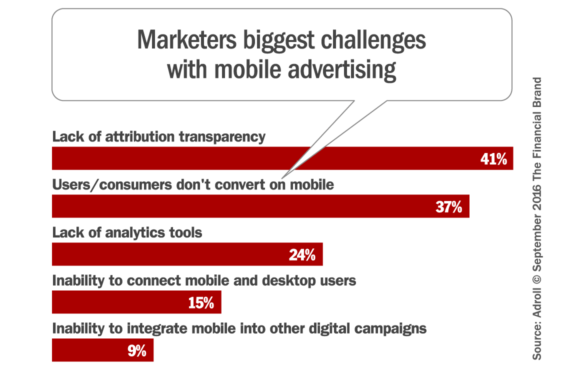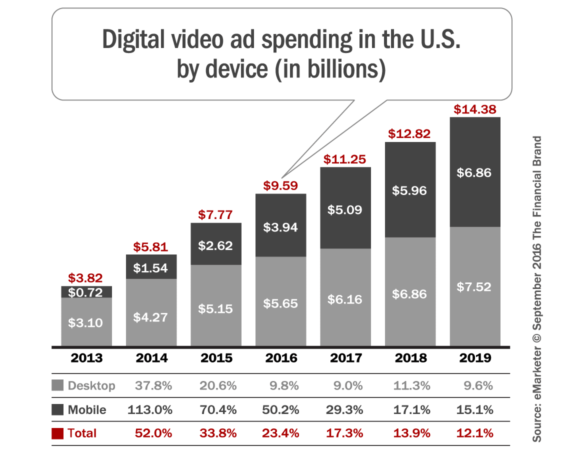thefinancialbrand.com
Banks and credit unions can’t afford to ignore marketing on mobile devices any longer. Social media, video and in-app advertising are among the options financial marketers must consider when crafting their digital marketing plan.
Not long ago, online display advertising was the darling of marketers and media buyers around the world. Today? Not so much.According to Zenith Optimedia, desktop advertising actually peaked back in 2014. It shrank by 0.2% in 2015, and online display ads are expected to decline another 0.9% in 2016.
Meanwhile, marketing on mobile devices is skyrocketing. In fact, Zenith says mobile has now overtaken desktop as the top internet advertising medium, and by 2018, mobile advertising will account for 58% of all internet advertising while desktop advertising will only account for 42%.
Mobile advertising grew at a staggering rate of 95% last year. Zenith forecasts additional of 46% in 2016, followed by 29% growth in both 2017 and 2018. eMarketer estimates that advertisers in the U.S. will spend $28.72 billion in 2016 to target consumers on mobile devices, and worldwide, that number is projected to reach nearly $100 billion.

Marketing on Mobile Devices Means Advertising in Social Media Channels
What’s behind all this growth? Advertising in social media channels. The average time spent on smartphones and tablets is approximately three hours in developed countries, of which 2.5 hours are devoted to social media apps on mobile devices.That’s why Facebook is crushing it. The strong performance of Facebook’s mobile advertising segment has helped the company achieve double-digit revenue growth in recent quarters. Facebook’s mobile ad revenues have risen by 81% year-over-year, reaching $5.2 billion or approximately 84% of its total advertising revenue.
Reality Check: It’s time for financial institutions to include social media advertising in their digital marketing plans.
In-App Marketing Trumps Browser-Based Display Ads
It’s important to note that mobile advertisements are not limited to display ads presented in browsers. Nearly 85% of the time users spend on their mobile device is spent in apps — not browsers. Therefore, more and more developers are trying to integrate mobile ads with the apps.Research firm Technavio says that enhancements and add-on features have provided apps with increased advertising opportunities. “Pop-up, display, and scroll ads hosted within apps are appropriate and are generated based on the data collected from user’s devices and their online behavior,” the firm says. “These advertisements are being prominently adopted, as they have higher sales conversion rates.”
The Rise of Mobile Video
One in three consumers watch video on their mobile devices, more than those who use their device to listen to music. And consider this: Of all minutes watched on YouTube, 40% is on smartphones.That’s why eMarketer says spending on mobile video advertising will grow more than 50% to reach $3.94 billion in 2016 — more than one-third of the estimated $9.59 billion to be spent on digital video ads. By 2019, mobile’s share of total digital video ad dollars is estimated to be about half.

Peggy Anne Salz, a contributor to Forbes, says mobile video — powered by mobile programmatic — is poised to rock the digital world. “Top line numbers show mobile video viewing is already eating into desktop’s leading share of video views,” Salz writes. “It’s a migration that can be attributed to the advance of high-speed 4G mobile networks that reduce latency, making mobile video accessible and enjoyable for more consumers in more markets.”
There’s also mounting evidence that people who watch video on their smartphone are giving it their full attention. Google and Ipsos researched 1,519 smartphone owners aged 18-34-years-old who were asked to keep a detailed diary of all of their online and offline video interactions. The results show that in a typical day, 98% of Millennials use smartphones to watch video content, and when they do, they are far less distracted than when watching video on any other screen, including TV. Video watching on TV was the sole activity just 28% of the time — meaning that only 28% of TV-viewing occasions were uninterrupted and fully garnered the users’ attention. Alternatively, video watching was the sole activity for 53% of mobile video sessions.

Reality Check: Most financial institutions haven’t even dabbled with online video advertising for desktops (e.g., pre-roll ads on YouTube). Financial marketers will be well behind the mobile marketing curve if they don’t integrate video into their strategy soon.
“Mobile video advertising brings a lot of value to marketers,” noted eMarketer in a report. “It primarily increases brand awareness, but it also helps with lead generation and yields better engagement over other advertising formats.”
No comments:
Post a Comment